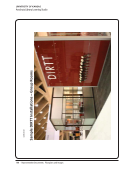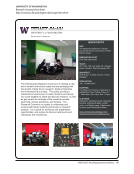78 · Survey Results: Survey Questions and Responses
Our library organization is undergoing tremendous change due to the implementation of a new strategic plan and
budget reductions happening simultaneously.
Our main library building is undergoing significant change. One-half of the book collection has been moved out to
storage. The goal is to reduce print journal collection by one-half. These changes have implications for what services and
what locations for them are needed.
Over the next three years, the campus Student Success Services will be housed within the main library. Consequently,
space and service points are being reconfigured.
Please understand that some of the changes in question 17 are still in the talking stages.
Ranganathan’s law is certainly holding true here. The library is indeed a “changing organism.” A desire to improve
user experience, as well as maximize librarian time allocation has resulted in the consolidation of three service points
to a single, combined service point. However, at the same time, a new learning commons is being built to include a
separate information service point with advising and other non-library activities also part of the suite of services. This
new learning commons service point will be managed and staffed by the library. So, as some service points consolidate
(circulation and reference), other service points are being added to reflect evolving responsibilities for the library.
Serving student demand for printing is significant. Semester limits for free printing by students were also introduced,
with fee-based printing provided. Conviction that a blank desk or table no longer sufficed as adequate academic
library work environment for students and that computer services for student belonged in the library and not elsewhere
on campus. Either a computer needs to sit on the library desk or the student connects his or her laptop wirelessly
(which the building has) with electricity provided (added to many desk locations in the building). Consistent student
government engagement with Dean of Students and University Librarian over years supported expansion of library
hours. Dean of students actively engaged by students in change in print policy modifications ensued.
UBC Library has 31 staffed library service point and 14 branches/divisions that provide reference services. The two
largest buildings are the Koerner Library and the Irving K. Barber Learning Centre—a multi-purpose renovated building
which includes the Library, Chapman Learning Commons, classrooms, academic units, Centre for Teaching and Learning
Technology, social spaces for students. The Reference Services Review Committee was formed in 2011 to review
reference services for the library system. The purpose is to identify possible models that might provide services in a
more accessible, consistent, cost-effective way, either by consolidation or other reconfigurations. The intent is also to
reallocate scarce resources to the emerging demands for services on copyright, scholarly communications, liaison with
faculty, instruction. At the same time, the intent is to maximize services that can be offered as self-serve (e.g., self-serve
circulation).
We are currently exploring new public service models and are exploring whether we could benefit from either a merged
reference/circulation model or one that brings them into closer proximity, or some model where there is only one service
desk for access services and the reference service is not operated from a desk but some other configuration. This is now
only in the discussion stage.
We continue to have more service points than most academic libraries by design. We feel that they offer better quality
service.
We have been consolidating service points for 15 years, first merging circulation and a distinct reserve room (down the
hall) in a 1995 renovation. Next, we incorporated service points in our periodical reading rooms into the work of the
information desk. Most recently, we moved ILL to the circulation/reserve service point for staff and user efficiencies, and
also to repurpose the original ILL space for a quiet reading room. Our primary purpose in consolidating service points is
to avoid user confusion and offer as many services as possible from a reduced number of service points. Our new service
Our library organization is undergoing tremendous change due to the implementation of a new strategic plan and
budget reductions happening simultaneously.
Our main library building is undergoing significant change. One-half of the book collection has been moved out to
storage. The goal is to reduce print journal collection by one-half. These changes have implications for what services and
what locations for them are needed.
Over the next three years, the campus Student Success Services will be housed within the main library. Consequently,
space and service points are being reconfigured.
Please understand that some of the changes in question 17 are still in the talking stages.
Ranganathan’s law is certainly holding true here. The library is indeed a “changing organism.” A desire to improve
user experience, as well as maximize librarian time allocation has resulted in the consolidation of three service points
to a single, combined service point. However, at the same time, a new learning commons is being built to include a
separate information service point with advising and other non-library activities also part of the suite of services. This
new learning commons service point will be managed and staffed by the library. So, as some service points consolidate
(circulation and reference), other service points are being added to reflect evolving responsibilities for the library.
Serving student demand for printing is significant. Semester limits for free printing by students were also introduced,
with fee-based printing provided. Conviction that a blank desk or table no longer sufficed as adequate academic
library work environment for students and that computer services for student belonged in the library and not elsewhere
on campus. Either a computer needs to sit on the library desk or the student connects his or her laptop wirelessly
(which the building has) with electricity provided (added to many desk locations in the building). Consistent student
government engagement with Dean of Students and University Librarian over years supported expansion of library
hours. Dean of students actively engaged by students in change in print policy modifications ensued.
UBC Library has 31 staffed library service point and 14 branches/divisions that provide reference services. The two
largest buildings are the Koerner Library and the Irving K. Barber Learning Centre—a multi-purpose renovated building
which includes the Library, Chapman Learning Commons, classrooms, academic units, Centre for Teaching and Learning
Technology, social spaces for students. The Reference Services Review Committee was formed in 2011 to review
reference services for the library system. The purpose is to identify possible models that might provide services in a
more accessible, consistent, cost-effective way, either by consolidation or other reconfigurations. The intent is also to
reallocate scarce resources to the emerging demands for services on copyright, scholarly communications, liaison with
faculty, instruction. At the same time, the intent is to maximize services that can be offered as self-serve (e.g., self-serve
circulation).
We are currently exploring new public service models and are exploring whether we could benefit from either a merged
reference/circulation model or one that brings them into closer proximity, or some model where there is only one service
desk for access services and the reference service is not operated from a desk but some other configuration. This is now
only in the discussion stage.
We continue to have more service points than most academic libraries by design. We feel that they offer better quality
service.
We have been consolidating service points for 15 years, first merging circulation and a distinct reserve room (down the
hall) in a 1995 renovation. Next, we incorporated service points in our periodical reading rooms into the work of the
information desk. Most recently, we moved ILL to the circulation/reserve service point for staff and user efficiencies, and
also to repurpose the original ILL space for a quiet reading room. Our primary purpose in consolidating service points is
to avoid user confusion and offer as many services as possible from a reduced number of service points. Our new service






















































































































































































































